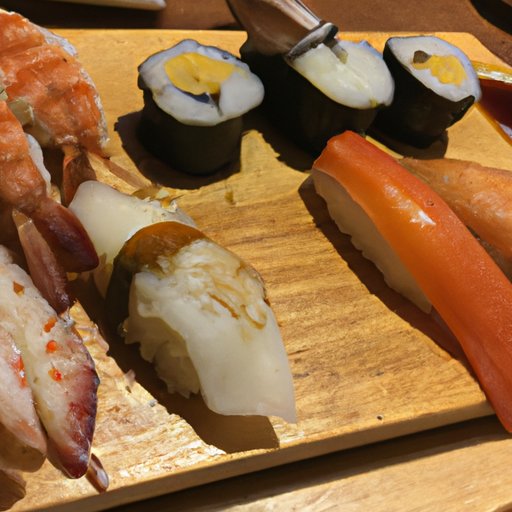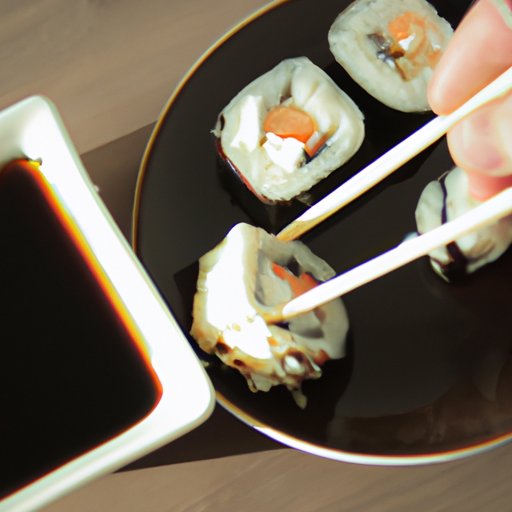Introduction
Sushi is a traditional Japanese dish made up of vinegared rice that is often combined with raw seafood or vegetables. The popularity of sushi has spread around the world and it is now enjoyed in many countries. Eating sushi can be a fun and enjoyable experience, but it’s important to know the proper etiquette for eating it.
In this article, we will explore how to eat sushi properly. We will discuss the different types of sushi, how to use chopsticks correctly, how to choose the right soy sauce, how to follow the order of eating sushi, and how to use wasabi sparingly. By following these tips, you can make the most out of your sushi experience!

Learn the Types of Sushi
The first step to eating sushi properly is to learn the different types of sushi and their ingredients. Sushi comes in many varieties, including nigiri, sashimi, maki, and temaki. Nigiri is a type of sushi made with a slice of raw fish on top of a small mound of vinegared rice. Sashimi consists of thin slices of raw fish served without any rice. Maki is a type of sushi roll made with vinegared rice and other ingredients, such as vegetables or raw seafood, wrapped in seaweed. Temaki is a type of hand roll made with vinegared rice and other ingredients, such as vegetables or raw seafood, wrapped in a cone shape with seaweed.
Once you have learned the different types of sushi and their ingredients, you can easily identify them by sight. For example, nigiri is easily recognizable by its distinct shape, with a slice of raw fish placed atop a small mound of vinegared rice. Maki can be identified by its cylindrical shape, while temaki is recognizable by its cone shape. Knowing the different types of sushi and being able to recognize them by sight will help you to enjoy your sushi experience even more.
Use Chopsticks Properly
Using chopsticks correctly is an essential part of eating sushi properly. To use chopsticks correctly, start by holding one chopstick between your thumb and index finger. Then, hold the other chopstick between your middle finger and ring finger. Make sure that the tips of both chopsticks are even. When picking up food, gently pinch the item with the tips of the chopsticks, while keeping the rest of the chopsticks steady.
When handling delicate sushi pieces, it is important to be gentle. If a piece of sushi is too large to pick up with your chopsticks, it is acceptable to cut it into smaller pieces before eating it. Additionally, it is important to remember not to rub the chopsticks together, as this is considered bad manners in many cultures.
Choose the Right Soy Sauce
Soy sauce is a key component when eating sushi. There are several types of soy sauce available, including light soy sauce, dark soy sauce, and tamari. Light soy sauce is the most commonly used type of soy sauce and it has a mild flavor. Dark soy sauce is thicker and has a stronger flavor than light soy sauce. Tamari is a type of soy sauce that is gluten-free and has a richer flavor than light or dark soy sauce.
When choosing which soy sauce to use, it is important to consider the type of sushi you are eating. For example, light soy sauce is best suited for lighter sushi, such as sashimi, while dark soy sauce is better suited for heavier sushi, such as nigiri. Tamari is also a great option for those who are looking for a gluten-free alternative. By taking the time to select the right soy sauce for your sushi, you can enhance the flavor of the dish.
Don’t Overload Your Plate
When eating sushi, it is important to take your time and savor each bite. It is easy to get carried away and overload your plate, but it is important to start with a few pieces at a time. This will help you to appreciate the flavors and textures of the sushi and make the experience even more enjoyable.
Follow the Order
When eating sushi, it is important to follow the order in which you should eat different types of sushi. Generally, it is best to start with lighter sushi, such as sashimi, followed by heavier sushi, such as nigiri. This will ensure that the flavors and textures of each type of sushi can be fully appreciated.
Research suggests that the order in which we eat our food can impact our enjoyment of the meal. According to a study published in the journal Appetite, participants who ate foods in a specific order reported greater satisfaction with the meal than those who ate the same foods in a random order. Therefore, it is important to follow the order when eating sushi in order to maximize the enjoyment of the experience.
Use Wasabi Sparingly
Wasabi is a green paste made from horseradish and is often served alongside sushi. It is often used to add a bit of heat and flavor to the dish. However, it is important to use wasabi sparingly, as too much can overpower the flavor of the sushi. The general rule of thumb is to use no more than a pea-sized amount of wasabi per piece of sushi.
Another way to use wasabi is to mix it with soy sauce to create a dipping sauce. This allows you to control the level of heat and flavor, as well as customize the flavor to your liking. By using wasabi sparingly, you can enhance the flavor of the sushi without overwhelming it.
Enjoy!
Eating sushi can be a fun and enjoyable experience. By following the tips outlined in this article, you can make the most out of your sushi experience. Take your time, savor each bite, and enjoy the flavors and textures of the various types of sushi. With a little practice, you can become a sushi master in no time!
Conclusion
In conclusion, eating sushi properly requires knowledge of the different types of sushi, proper chopstick usage, choosing the right soy sauce, following the order of eating sushi, and using wasabi sparingly.
(Note: Is this article not meeting your expectations? Do you have knowledge or insights to share? Unlock new opportunities and expand your reach by joining our authors team. Click Registration to join us and share your expertise with our readers.)
